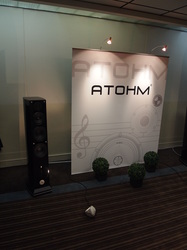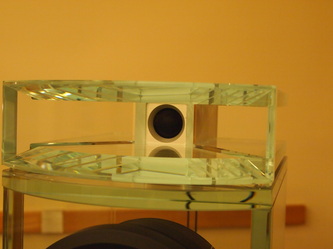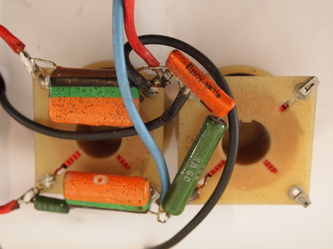 Roquemaure is a picturesque village on the west bank of the Rhone river, drinking distance from Chateauneuf-du-Pape, Lirac, Tavel and many more famous wineries - including my favourite Cotes-du-Rhone: Vidal-Fleury! Christophe Bedel, the enthusiastic and knowledgeable owner of related website www.hifi-vintage-audiophile.fr has just been in contact with me asking if I could promote this event on my blog. I couldn't refuse! In fact, I am trying to convince Greg Borrowman from AHM, who will be in France at that time visiting Focal and hopefully Waterfall Audio to stop by and report on the only fair of this type I know of in the South of France! This is good timing too as a number of Festivals are happening in the region over the summer period, with usually a fantastic array of live concerts to choose from - Avignon being the most famous of them, but Uzes, Carpentras, Bagnols sur Ceze, La Roque d'Antheron ( a must!), Aix en Provence, Orange and Nimes all competing for your time (and good money..) So, if you are one of 43 out of 100 Australians out of the country at any given time, or one of my readers in any of the 70 countries or so where I have an audience, and if you happen to be in Provence for the European Summer, just drop by and have a look at the fantastic collection of vintage Hifi that will be on display and for sale! I will update this post with an exact address as soon as I get it, but if your French is good enough, then visit Christphe's website: www.hifi-vintage-audiophile.fr  Guess what: I got an email yesterday from Focal to update me on their new website address!. They also have revamped the website quite interestingly. So here it is: www.focal.com That's great news as the previous domain name (focal-fr.com) was obviously a bit parochial... I wonder how much it cost to buy back this domain... Anyway, this is great news and a tribute to the export success of the company. I have also been enticed to post a link to more information on the Grande Utopia, than I am more than happy to give it to you: http://www.focal.com/en/home-audio-loudspeakers/utopia-iii.php. There is also what we call a microsite dedicated to the Grande Utopia EM: http://www.grande-utopia-em.com/grande-utopia-em.php Today, I will review the two brands/products that have most impressed me in terms of speaker design and new to me. Atohm and Waterfall Audio are kind of cousins as Thierry Comte is a partner in Waterfall, and the main driver (sic...) behind Atohm. Besides, Waterfall Audio uses almost exclusively Atohm speakers. Both companies have created a range of speakers that have some design criteria in common, but have achieved very different products out of some of the same components. Atohm drivers are all high efficiency and both bass and midrange drivers have a metal membrane. Their top of the range tweeter however has a silk membrane and a 28mm diameter coil small enough to always stay within the humongous magnetic field of more than 17000 Gauss, resulting in a massive 98db/w/m efficiency. We were exposed to their top model, the GT 3.0, a so-called 3.5 way freestanding speaker beautifully finished and equipped with 2 7inch bass drivers, 1 6inch medium with a phase plug and the above mentioned supertweeter. The crossover frequencies are 100, 150 and 2500Hz, hence the 3.5 way name. All filter slopes are 6db and the tweeter is time aligned. The midrange driver has its own chamber fitted with an internal conical structure aimed at taming the standing waves and reflections inside that cabinet. This is reminiscent of the structure in the B&W Nautilus, but inverted inside the cabinet. The bass drivers are installed in a bass reflex enclosure with a laminated vent at the base of the speaker's cabinet (like in our Microphase SWS subwoofer, this arrangement removes most of the potential problems linked with the floor structure and the position within the room). The very well conducted demo showed the accuracy, speed and time alignment of this speaker, highly respecting the timbres of instruments and at 92db efficiency and 300W power capacity, reproducing the music with a realistic level and a total absence of distortion. Definitely in my top five at the show. Their cost of 7,900 euros + seems to be the norm at that level of quality (Elipson 4260, Vienna Acoustics, or my favourite Martin Logans are twice the price...) Waterfall Audio has taken a different approach, using some of the same drivers, in their top model, the Niagara.
First of all, Waterfall has made a name for themselves by introducing glass cabinets for their speakers. We all know that glass is a very inert material, but being transparent, one cannot hide much inside the cabinet. Besides, it is quite a difficult material to process and assemble, more so once you add the complexity of a horn in front of the tweeter! But Cedric Aubriot and Thierry Combe are not the types to refuse a challenge, and they came up with a number of innovative ideas to make this speaker a "chef d'oeuvre" in the sense of the Compagnons in the Middle Ages. The result is a beautiful objet with a very high WAF - they have their Export Manager, Nadine, as their first judge, and she has convinced women (and men, I am sure...) in 30 countries to agree with her and buy this wonderful object! Having said that, the auditive result is totaly in tune with the aesthetics of the product, proving once more that form should follow function if one wants to achieve the best possible results in any field. Electroacoustics are still full of "black magic" and in this case a transparent one: the filter is hidden in the base of the speaker, and so is the larger passive bass driver. Again, the midrange driver has its own enclosure baptised Acoustic Damping Tube, and the bass is generated mainly by a second 7inch driver. The tweeter is a 21mm diameter with a silk cone behind the proprietary glass horn. All drivers are bespoke versions of Atohm drivers. The sound is solid, accurate and neutral. At 89db and 200w power handling, the output is realistic with a very nice, precise soundstage. At 27,000 euros, this is not for the faint hearted, but a tenth of the price of a Focal Utopia and a lot easier to fit in one's living room. And with all due respect to Jacques Mahul, a much more lively proposition, more engaging with the source material, and, after a relatively short audition, certainly not less accurate. It is to be noted here that Len Wallis (of Len Wallis Audio fame in Sydney) has given me access for a full morning to the Utopia in his showroom with two of his most knowledgeable sales people (and vinyl enthusiasts on top...) as my 60th birthday present...and so, my opinion of the Utopia is based on a much longer listening session on my own material. Although we had probably hal a million dollars of equipment in that room, I cannot say I was totally convinced mainly because it was almost surgical and lack the passion to engage my senses totally. So, if I had a spare 40,000A$, I would certainly consider the Niagara! I would like to try them with my Bryston amp and a Michell turntable and Grado Signature cartridge. Maybe the Aussie distributor of Waterfall Audio can organise that for me ( I will BYO my amp!!!) The cabinet As previously described in my last post, the cabinet was designed as small as possible to match a MIDI system and big enough to allow enough bass. The final dimensions were set as 200x200x150mm, giving us a 3.9 litres internal volume. The cabinets were provided as a mirror-image set. This is a bass-reflex arrangement with a 2.5cm diam, 4cm long port generating a -6dB point at 70 Hz. Because the voice coil is longer than the standard version, one can adjust the bass control on the preamplifier (sacrilege...) and extend the bass output down to 50 Hz without distortion at normal listening level in a small room - which was our target market to start with. We will discuss in a later post how we increased the bass output with the addition of subwoofer(s) We had been looking at various materials to build the cabinet, and apart from the obvious MDF, we wanted something that, once varnished, would show the material itself, so we settled on a very dense marine birch plywood, 15mm thick. We shopped around for a cabinet maker and Philippe Lesage recommended we talked to Jean-Paul Guy of Guy HF in Bourbon-Lancy, a small town in the centre of France, not far from St-Etienne, famous for its manufacture of weapons, and for us audiophiles, where Focal-JMLab and Jacques Mahul operate. Philippe had said to me that Jean-Paul was rarely taking new clients on, but that my design might interest him. It is quite a trek from Paris to Bourbon-Lancy, but after a few phone conversations, I decided to go with a pair of prototypes made in Paris. Jean-Paul asked many questions, listened to our product, and started suggesting a few modifications/upgrades and manufacturing tips: We were in! At the time, Focal had started 4 years before and was beginning to be a serious client for Guy HF, so much so that it ended up taking 49% of the shares in 2003 and bought the company over when Jean-Paul decide to retire. He is still a technical consultant and the factory is making the top of the range from Focal-JMLab today, as in the Utopia and avatars. One thing that Jean-Paul was an expert at, among other things, was the varnish: we never found anybody that could do a varnish that was not shiny, but smooth as an anodised aluminium finish. That gave our speakers an elegance that nobody else could match at any price. The filter
We chose a Linkwitz-Riley configuration because this 12 dB per octave crossover is designed to solve the problem of centering the main lobe of the forward radiation pattern of a two-way speaker system. This crossover is unusual in that each filter is down 6 dB at crossover (in this case around 5400hz, to avoid the resonance of the tweeter and take advantage of the full range of the bass/midrange driver) and that the two drivers are actually "in phase" at all frequencies when the drivers are wired in opposite polarity. That is, even though the filters have their own characteristic phase responses the phase difference between the two output signals is the same at all frequencies. As a result, each filter section has the same group delay. This crossover is recommended over the 2nd order Butterworth type due to its accurate summed frequency response and forward pointing main lobe. We also aligned the two drivers physically to adjust the time delay between the tweeter and bass/midrange driver. This also gave the cabinet its typical look, showing the structure of the plywood on the edge of the "pyramid" supporting the main driver, a very ancient Egyptian concept. This eventually translated into the name and the logo of the company. Here is a schematic of the filter and a photo of its implementation: |
AuthorBorn in France, well travelled, relocated to Sydney in 1997. Archives
July 2023
Categories
All
|
















 RSS Feed
RSS Feed
